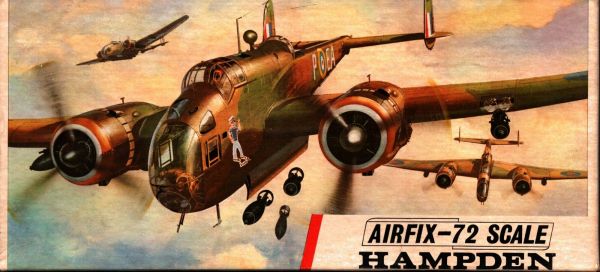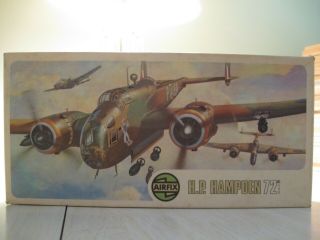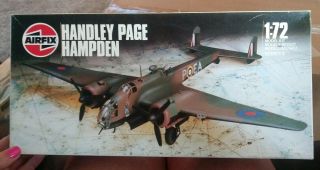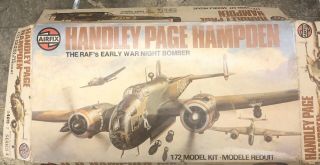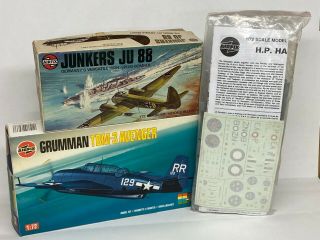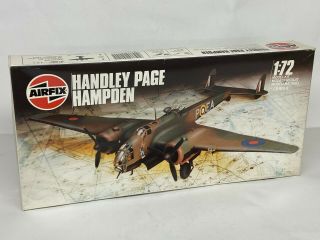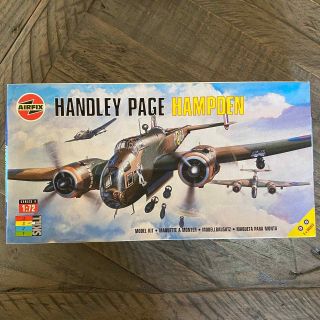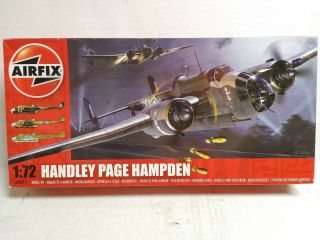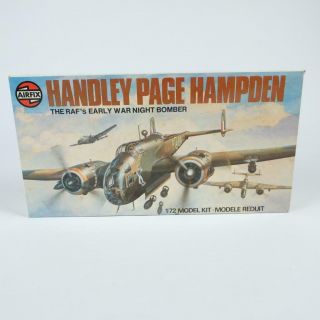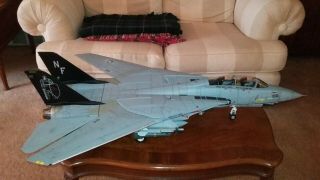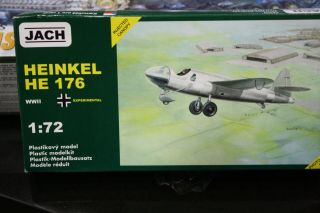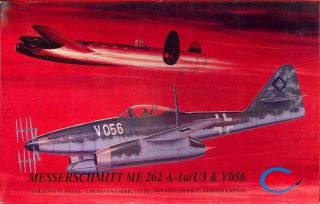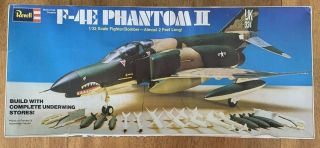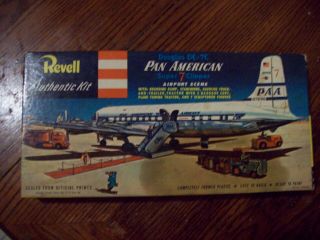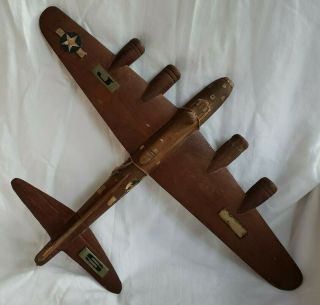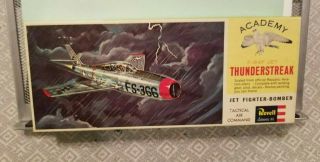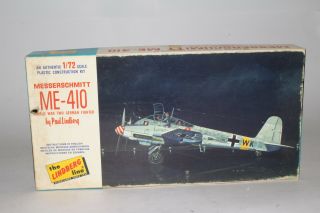AIRFIX 1/72 HANDLEY PAGE HAMPDEN WW2 RF BOMBER Kit No. 491 (1968) No. 49 SQN
Item History & Price
| Reference Number: Avaluer:60548806 |
AIRFIX1/72 HANDLEY PAGE HAMPDEN WW2 RF BOMBER Kit No.491 (1968) No.49 SQNOPEN BOX UNBUILT PLASTIC MODELKIT – INVENTORIED 100% COMPLETE. Includes Original Instructions and Decals.IF YOU HAVE ANY QUESTIONS ORCONCERNS PLEASE ASK ME BEFORE BIDDING / PURCHASING – I WANT EVERYONE TO BE 100%SATISFIED WITH NO SURPRISES OR MIS-UNDERSTANDINGS***IF YOU DE...SIRE TO PURCHASEMULTIPLE KITS AT THE SAME TIME – I WILL COMBINE INTO A SINGLE SHIPMENT ANDADJUST THE INVOICE TO REFLECT THE MOST ECONOMICAL POSTAGE CHARGE FOR ALL ITEMSSHIPPED TOGETHER***--------------------------------------------Additional Information fromInternet EncyclopediaThe Handley Page HP.52 Hampdenwas a British twin-engine medium bomber of the Royal Air Force (RAF). It waspart of the trio of large twin-engine bombers procured for the RAF, joining theArmstrong Whitworth Whitley and Vickers Wellington. The newest of the threemedium bombers, the Hampden was often referred to by aircrews as the"Flying Suitcase" because of its cramped crew conditions.[1] TheHampden was powered by Bristol Pegasus radial engines but a variant known asthe Handley Page Hereford had in-line Napier Daggers.The Hampden served in the earlystages of the Second World War, bearing the brunt of the early bombing war overEurope, taking part in the first night raid on Berlin and the first1, 000-bomber raid on Cologne. When it became obsolete, after a period of mainlyoperating at night, it was retired from RAF Bomber Command service in late1942. By 1943, the rest of the trio were being superseded by the largerfour-engined heavy bombers such as the Avro Lancaster.DevelopmentOriginsIn 1932, the Air Ministry issuedSpecification B.9/32 seeking a twin-engined day bomber with higher performancethan any preceding bomber aircraft.[2] Accordingly, Handley Page responded withtheir design to meet the requirements of B.9/32; this same specification alsodrew other submissions from rival aircraft manufacturers such as Vickers, whowould proceed to develop the Wellington bomber to it. The design team, led byGeorge Volkert, drafted an extremely radical aircraft, initially centering uponthe politically-favoured Rolls-Royce Goshawk engine; however, by mid-1934, development of the Goshawk looked less promising and thus the Air Ministryacted to relax the tare weight (unloaded weight) requirement of thespecification, allowing for the use of heavier and more powerful radial enginessuch as the Bristol Perseus and Bristol Pegasus. According to aviation authorPhilip J.R. Moyes, the Handley Page design soon found support with the AirMinistry in part because it was judged to represent a fair compromise betweenrange, payload, and speed.During early 1936, the firstprototype, designated as the HP.52 and given the serial number K4240, wascompleted. On 21 June 1936, the prototype, powered by a pair of Bristol PegasusP.E.5S(A) engines, conducted its maiden flight from Radlett Aerodrome, Hertfordshire, piloted by Handley-Page Chief Test Pilot Major J. L. H. B.Cordes.[2] In late June 1936, the prototype was put on public display in theNew Types Park, Hendon Air Show, London. In August 1936, in response to thesuccessful flight trials performed by K4240, the Air Ministry issued an initialproduction order for the type, ordering 180 production aircraft to bemanufactured to meet Specification B.30/36; concurrently, a second order for100 aircraft powered by the Napier Dagger was issued to Belfast-based Short& Harland.In early 1937, a secondprototype, which received the serial number L7271, was completed; this secondprototype had several differences from the first, including the pitot tubebeing repositioned below the fuselage, a more rounded ventral gun turret, and aslightly modified nose.[4] L7271 later received a pair of Dagger engines andwas accordingly re-designated as the HP.53; on 1 July 1937, it performed itsfirst flight after having received the new engines. Another prototype, L4032, was produced to serve as the production-standard prototype; on 24 June 1938, the third prototype conducted its maiden flight.[4] L4032 differed from theprevious two prototypes in that it was powered by a pair of Pegasus XVIIIengines, the nose incorporated an optically-flat bomb-aiming panel, as well asthe ventral and dorsal gun positions being revised.Handley Page elected to nametheir new aircraft after John Hampden, a 17th-century British politician anddefender of civil liberties.[2] On 24 June 1938, L4032 was officiallychristened by Lady Katharine Mary Montagu Douglas Scott, Viscountess Hampden, at a ceremony held in Radlett Aerodrome, the same day on which its first flighttook place.[4][5] L4032 and L4033, which was the second production-standardHampden to be produced, would be later assigned to the Aeroplane and ArmamentExperimental Establishment at RAF Martlesham Heath, Suffolk.[6] On 20 September1938, the third production Hampden, designated L4034, following the completionof handling trials conducted by the Central Flying School at Upavon Aerodrome, Wiltshire, become the first aircraft to enter RAF squadron service, beingdelivered to No. 49 Squadron.ProductionBy late 1938, the massmanufacturing plans for the Hampden had been formalised. In addition toHandley-Page's own production line, the type was to be built under subcontractby English Electric at their factory in Preston, Lancashire; on 6 August 1938, English Electric was awarded an initial contract to manufacture 75 Hampdens.[7]In addition, Canadian interest in domestic production of the type had resultedin the establishment of the joint Anglo-Canadian Canadian Associated Aircraftcompany, which promptly received an initial order from the RAF for 80 Hampdensto be completed in Canada; this facility would effectively act as a shadowfactory during wartime.[7] On 1 September 1938, in response to interestexpressed by the Royal Swedish Air Force (RSAF) in the Hampden, including in apotential licence production arrangement for 70 aircraft to be built in Sweden, a single production Hampden was supplied to Sweden. Designated P.5 by the RSAF, it was operated by the service through to November 1945, after which it wassold to Svenska Aeroplan AB (SAAB) to serve as a flying testbed before beingretired in late 1947.On 22 February 1940, the firstPreston-built Hampden, P2062, conducted its maiden flight. English Electricwould go on to manufacture a total of 770 Hampdens, more than any othercompany, prior to delivering its final aircraft on 15 March 1942.[8] In July1940, Handley-Page terminated its own production line for the Hampden upon thecompletion of its 500th aircraft.[8] On 9 August 1940, the first Canadian-builtHampden, P5298, made its first flight; by October 1940, Canadian production hadrisen to 15 aircraft per month.[8] A total of 160 Hampdens were completed byCanadian Associated Aircraft, many of which were ferried to the United Kingdomfor wartime service. The final Canadian-built aircraft was delivered in late1941.DesignThe Hampden Mk I had a pilot, navigator/bomb aimer, radio operator and rear gunner. Conceived as a fast, manoeuvrable "fighting bomber", the Hampden had a fixedforward-firing .303 in (7.7 mm) Browning machine gun in the upper part of thefuselage nose. To avoid the weight penalties of powered turrets, the Hampdenhad a curved Perspex nose fitted with a manual .303 in (7.7 mm) Vickers Kmachine gun and a .303 in (7.7 mm) Vickers K installation in the rear upper andlower positions. The layout was similar to the all-guns-forward cockpitsintroduced about the same time in Luftwaffe medium bombers, notably the DornierDo 17. During the Norwegian Campaign, these guns proved to be thoroughlyinadequate for self-defence in daylight; the single guns were replaced by twinVickers K guns, a process led by Air Vice Marshal Arthur Harris of No. 5 GroupRAF in 1940.The Hampden had a flush-rivettedstressed skin, reinforced with a mixture of bent and extruded sections in anall-metal monocoque design.[11] A split-assembly construction technique wasemployed: sections were prefabricated and then joined, to enable rapid andeconomic manufacture. The fuselage was in three big sections – front, centreand rear – that were built using jigs. The centre and rear sections were madeof two halves, which meant that the sections could be fitted out in part underbetter working conditions prior to assembly. All possible assembly work wasperformed at the benches prior to installation upon each aircraft.Hampden cockpitThe wings were made up of threelarge units: centre section, port outer wing and starboard outer wing, whichwere also subdivided.[12] Each section was built around a main girder spar, leading edge section and trailing edge section.[11] The wing made use ofwingtip slots and hydraulically-actuated trailing edge flaps; the flaps andailerons had stress-bearing D-spars.[11] According to Moyes, the configurationof the wing was a key feature of Hampden, being highly tapered and designed toexert low levels of drag; these attributes were responsible for the aircraft'shigh top speed for the era of 265 mph (230 kn; 426 km/h) while retaining areasonably low landing speed of 73 mph (63 kn; 117 km/h).The Hampden's flying qualitieswere typically described as being favourable; Moyes described it as being"extraordinarily mobile on the controls".[13] Pilots were providedwith a high level of external visibility, assisting the execution of steepturns and other manoeuvres. The control layout required some familiarisation, as some elements such as the hydraulic controls were unobtrusive andunintuitive. Upon introduction, the Hampden exhibited greater speeds andinitial climb rates than any of its contemporaries while still retainingfavourable handling qualities.The slim and compact fuselage ofthe aircraft was quite cramped, being wide enough only for a single person. Thenavigator sat behind the pilot and access in the cockpit required folding downthe seats. Once in place, the crew had almost no room to move and weretypically uncomfortable during long missions. Aircrews referred to the Hampdenby various nicknames due to this, such as Flying Suitcase, Panhandle, andFlying Tadpole.I did my first flight and firsttour on Hampdens. A beautiful aeroplane to fly, terrible to fly in! Cramped, noheat, no facilities where you could relieve yourself. You got in there and youwere stuck there. The aeroplane was like a fighter. It was only 3 feet wide onthe outside of the fuselage and the pilot was a very busy person. There were111 items for the pilot to take care of because on the original aircraft he hadnot only to find the instruments, the engine and all that, but also he had allthe bomb switches to hold the bombs.— Wilfred John 'Mike' LewisOperational historyUK serviceScale comparison diagram of thetrio of British twin-engined medium bombers at the outbreak of the Second WorldWar; the Hampden (yellow), the Vickers Wellington (blue) and the ArmstrongWhitworth Whitley (pink)In September 1938, No. 49Squadron received the first Hampdens; by the end of the year, both 49 and 83Squadrons at RAF Scampton had re-equipped with the type.[15] A total of 226Hampdens were in service with ten squadrons by the start of the Second WorldWar, with six forming the operational strength of 5 Group of Bomber Commandbased in Lincolnshire.With the outbreak of war in1939, Hampdens were initially used to perform armed aerial reconnaissancemissions, observing German naval activity during daylight.[17] However, despiteits speed and manoeuvrability, the Hampden proved to be no match for Luftwaffe fighters;in December 1939, Bomber Command is claimed to have discarded the belief thataircraft such as the Hampden could realistically operate by day and insteadchose to predominantly employ them under the cover of darkness during nighttimeoperations.[17] During 1940, Hampdens of 5 Group conducted 123 nighttimeairborne leaflet propaganda missions, losing only a single aircraft in theprocess.On 13 April 1940, days afterGermany's invasion of Norway, a large number of Hampdens were dispatched on night-timemine-laying (code-named "gardening") flights in the North Sea inareas deemed unapproachable by British shipping. According to Moyes, thisactivity proved highly effective, experiencing a low casualty rate of less than1.9 aircraft per sortie.[17] The Hampden also saw a return to its use as adaytime bomber during the Norwegian Campaign, but quickly proved to beunder-gunned in the face of German fighters.On 19 March 1940, Hampdens tookpart in the first deliberate bombing of German soil in a nighttime raid uponthe seaplane hangars and slipways in Hörnum, Sylt.[8] The type continued tooperate at night on bombing raids over Germany. Flight Lieutenant Rod Learoydof 49 Squadron was awarded the Victoria Cross for a low-level attack on theDortmund-Ems canal on 12 August 1940 where two of five aircraft failed toreturn.[18][19] On 25 August 1940, Hampdens from various squadrons participatedin the RAF's first bombing raid on Berlin.[20] Sergeant John Hannah was thewireless operator/air gunner of an 83 Squadron Hampden and was awarded theVictoria Cross on 15 September 1940, when he fought the flames of the burningaircraft, allowing the pilot to return it to base.In April 1942, theHampden-equipped 144 Squadron and 455 Squadron RAAF were transferred fromBomber Command to Coastal Command to perform the torpedo bomber role. Laterthat year, detachments from both squadrons were dispatched to Vaenga airfield, Murmansk, Russia, to help safeguard the Arctic convoys in the vicinity.[20] Atotal of four squadrons assigned to Coastal Command would be equipped withHampdens. These squadrons continued to use the type into late 1943; the lastCoastal Command squadron transitioned from the type on 10 December 1943.Almost half of the Hampdensbuilt, 714, were lost on operations, with 1, 077 crew killed and 739 reported asmissing. German Flak accounted for 108, one hit a German barrage balloon, 263Hampdens crashed because of "a variety of causes" and 214 others wereclassed as "missing". Luftwaffe pilots claimed 128 Hampdens, shootingdown 92 at night.The last Bomber Command sortiesby Hampdens were flown on the night of 14/15 September 1942 by 408 Squadron, RCAF against Wilhelmshaven.[23] After being withdrawn from Bomber Command in1942, it operated with RAF Coastal Command through 1943 as a long-range torpedobomber (the Hampden TB Mk I with a Mk XII torpedo in an open bomb bay and a500-pound (230 kg) bomb under each wing) and as a maritime reconnaissanceaircraft.Non-UK serviceThe Hampden was also used by theRoyal Canadian Air Force (RCAF), Royal Australian Air Force (RAAF), Royal NewZealand Air Force (RNZAF), Aviatsiya Voenno-Morskogo Flota (AV-MF: MaritimeMilitary Fleet Aviation) of the Soviet Union and the Swedish Flygvapnet (AirForce).The Hampden in RCAF serviceincluded the 160 examples manufactured in Canada by the Victory Aircraftconsortium. Of the total built, 84 were shipped by sea to Great Britain, whilethe remainder came to Patricia Bay (Victoria Airport) B.C., to set up No. 32OTU (RAF) used for bombing and gunnery training. Typical exercises at 32 OTUconsisted of patrolling up the West Coast of Vancouver Island at night orflying out into the Pacific to a navigational map co-ordinate, often in adverseand un-forecast inclement weather. Due to attrition from accidents, about 200"war weary" Hampdens were later flown from the U.K. to Pat Bay asreplacements.In Operation Orator, duringSeptember 1942, the crews of 32 Hampden TB.1 torpedo bombers from No. 144Squadron RAF and No. 455 Squadron RAAF flew to Northwest Russia, to protectarctic convoy PQ 18 from German surface vessels, such the battleship Tirpitz.The Hampden crews flew from Sumburgh in the Shetland Islands to Vaenga(Vayenga; later known as Severomorsk) in Murmansk Oblast, Russia. This was ahazardous route, often subject to poor weather and spanning more than 2, 100nautical miles (3, 900 km), partly over enemy-occupied territory in Norway andFinland. Eight Hampdens were lost or damaged beyond repair enroute.[25][26][27] 144 and 455 Squadrons flew a small number of sorties fromVaenga. While it was originally intended that the Hampdens would be flown backto Scotland, the prevailing west-east headwinds on such a flight might havepushed the Hampdens beyond their maximum endurance and it was decided totransport the wing's personnel back to Britain by sea and gift the Hampdens tothe Soviet Navy.Aircrews and mechanics fromMaritime Military Fleet Aviation (Aviatsiya Voenno-Morskogo Flota; VMF) weretrained by members of 144 and 455 Squadrons, before their return to Britain inOctober.[28] The 3rd Squadron, 24th Mine-Torpedo Aviation Regiment (24Минно-торпедный авиаполк; 24 MTAP) operated the "balalaika" – theRussian nickname for the Hampden, in reference to its unusual shape – untilmid-1943, [29] when losses, a lack of replacements and a shortage of sparesforced its retirement. 24 MTAP then reverted to the Ilyushin DB-3/IlyushinIl-4.In Sweden, the Flygvapnetassigned an HP.52 to Reconnaissance Wing F 11 at Nyköping for evaluation, underthe designation P5. After the war, the aircraft was sold to SAAB where it wasused as an avionics testbed.VariantsThe Hampden was powered by two980 hp (730 kW) Bristol Pegasus XVIII nine-cylinder radial engines. A Mk IIvariant, designated the HP.62, was developed by converting two Hampdens to usethe 1, 000 hp (750 kW) Wright Cyclone engine in 1940, but no further work wasdone on that project.[20]Interest in the HP.52 by theSwedish Air Force led to the creation of the HP.53 prototype, which wassubsequently used as a testbed for a pair of 1, 000 hp (750 kW) Napier DaggerVIII 24-cylinder H-block air-cooled inline engines.In August 1936, the Air Ministryplaced an order for 100 Hampdens equipped with the Dagger engine. Thoseaircraft subsequently received the designation HP.53, along with the nameHereford.[3] Manufactured by Short & Harland in Belfast, their performancewas almost identical to that of their Hampden cousins, but there were problemswith the engines.[30] From the outset, the Dagger engine proved to beproblematic, being both noisy and unreliable. In particular, cooling problemsplagued the engine while being run on the ground, resulting in distortions andpremature failures.[31] The problems were not satisfactorily resolved, with theresult that most of the Herefords on order were converted to Hampdens instead, while those that were constructed were often re-engined to become Hampdens. Alimited number of Herefords did enter squadron service, but were only used ascrew trainers by training units.OperatorsHampden AustraliaRoyal Australian Air ForceNo. 455 Squadron RAAF Usedbetween July 1941 and December 1943, Codeletters UB.[32] CanadaRoyal Canadian Air ForceNo. 408 (Goose) Squadron RCAFUsed with RAF Bomber Command between July 1941 and September 1942, CodelettersEQNo. 415 (Swordfish) SquadronRCAF Used as a torpedo bomber with RAF Coastal Command between February 1942and November 1943, Codeletters GXNo. 420 (Snowy Owl) SquadronRCAF Used with RAF Bomber Command between December 1941 and August 1942, Codeletters PTNo. 32 Operational Training UnitRAF/RCAF Used in Canada between May 1942 and February 1944, Codeletters DK, LB, OP and RONew ZealandRoyal New Zealand Air ForceNo. 489 Squadron RNZAF Usedbetween February 1942 and November 1943, Codeletters XASoviet UnionSoviet Naval Aviation24th Mine-Torpedo AviationRegiment (24 MTAP)SwedenSwedish Air ForceReconnaissance Wing F 11 basedat Nyköping operated a single HP.52 for evaluation under designation P 5. Afterthe war, the aircraft was sold to SAAB where it was operated for testingavionics.United KingdomHandley Page Hampden of No. 83Squadron with crew, seated on a loaded bomb trolley at Scampton, October 1940Hampden in the process of beingloaded with bombs by ground crewAircrews of No. 50 Squadron infront of their Hampdens at Waddington, Lincolnshire, shortly after returningfrom a raid on the German fleet in the Bergen Fjord, Norway, on 9 April 1940Royal Air ForceNo. 7 Squadron RAF – April 1939to April 1940, code letters LT (pre-war) and MG (wartime)No. 44 Squadron RAF – February1939 and December 1941, code letters JW (pre-war) and KM (wartime)No. 49 Squadron RAF – October1938 and April 1942, code letters XU (pre-war) and EA (wartime)No. 50 Squadron RAF – December1938 and April 1942, code letters QX (pre-war) and VN (wartime)No. 61 Squadron RAF – February1939 and October 1941, code letters LS (pre-war) and QR (wartime)No. 76 Squadron RAF – March 1939and April 1940, code letters NM (pre-war) and MP (wartime)No. 83 Squadron RAF – November1938 and January 1942, code letters QQ (pre-war) and OL (wartime)No. 97 Squadron RAF –July/August 1941, squadron code OFNo. 106 Squadron RAF – March1939 to March 1942, code letters XS (pre-war) and ZN (wartime)No. 144 Squadron RAF – March1939 to October 1942, code letters NV (pre-war) and PL (wartime)No. 185 Squadron RAF – June 1939to April 1940, code letters ZM (pre-war) and GL (wartime)No. 207 Squadron RAF –July/August 1941, squadron code EMNo. 517 Squadron RAF – August toNovember 1943, No. 519 Squadron RAF – August toNovember 1943, code letters Z9No. 521 Squadron RAF – Septemberto December 1943, code letters 5ONo. 5 (C)OTU RAF Used betweenJuly 1942 and September 1943, Only individual code letters and numbersNo. 14 Operational Training UnitRAF Used between 5 May 1940 and December 1942, code letters AM, GL and VBNo. 16 Operational Training UnitRAF Used between 18 April 1940 and September 1942, code letters GA, JS and XGNo. 25 Operational Training UnitRAF Used between February and December 1941, code letters ZPNo. 1401 (Meteorological) FlightRAF at RAF Bircham Newton/RAF DockingNo. 1402 (Meteorological) FlightRAF at AldergroveNo. 1403 (Meteorological) FlightRAF at Gosport/Bircham Newton/GibraltarNo. 1404 (Meteorological) FlightRAF at St. EvalNo. 1406 (Meteorological) FlightRAF at WickNo. 1407 (Meteorological) FlightRAF at Reykjavik
Shipping & HandlingBack to Top US ShippingPlease check eBay's Shipping & Payment tab
USPS Priority Mail®
International ShippingPlease check eBay's Shipping & Payment tab
USPS First-Class Mail International (Worldwide)
USPS First-Class Mail International (Canada)
FREE scheduling, supersized images
and templates. Get Vendio Sales Manager.Make your listings stand out with
FREE Vendio custom templates!
FREE scheduling, supersized images
and templates. Get Vendio Sales Manager.
Over 100, 000, 000 served. Get FREE counters from Vendio today!



